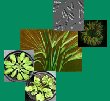| Renz, A; Schikora, S; Schmid, R; Kossmann, J; Beck, E: cDNA sequence and heterologous expression of monomeric spinach pullulanase: multiple isomeric forms arise from the same polypeptide, Biochemical Journal, 331, 937-945 (1998), doi:10.1042/bj3310937 | |
| Abstract: The spinach pullulanase gene was cloned and sequenced using peptide sequences of the purified enzyme as a starting point and employing PCR techniques and cDNA library screening. Its open reading frame codes for a protein of 964 amino acids which represents a precursor of the pullulanase. The N-terminal transit peptide consists of 65 amino acids, and the mature protein, comprising 899 amino acids, has a calculated molecular mass of 99 kDa. Pullulanase is a member of the α-amylase family. In addition to a characteristic catalytic (β/α)8-barrel domain, it contains a domain, F, that is specific for branching and debranching enzymes. Pullulanase cDNA was expressed in Escherichia coli, and the purified protein was compared with the enzyme from spinach leaves. Identity of the two proteins was confirmed in terms of catalytic properties, N-terminal amino acid sequences and molecular masses. The pullulanase produced by E. coli showed the same microheterogeneity as the spinach leaf enzyme: it could be resolved into two substrate-induced forms by electrophoresis in amylopectin-containing polyacrylamide gels, and, in the absence of substrate, into several free forms (charge isomers) by isoelectric focusing or chromatofocusing. Rechromatofocusing of single free forms resulted in the originally observed pattern of molecular forms. However, heterogeneity of the protein disappeared on isoelectric focusing under completely denaturing conditions when only one protein band was observed. Post-translational modifications such as glycosylation and phosphorylation could be excluded as potential explanations for the protein heterogeneity. Therefore the microheterogeneity of spinach leaf pullulanase results from neither genetic variation nor post-translational modifications, but is a property of the single unmodified gene product. The different interconvertible forms of the pullulanase represent protein populations of different tertiary structure of the same polypeptide. |

Letzte Änderung 06.07.2020

